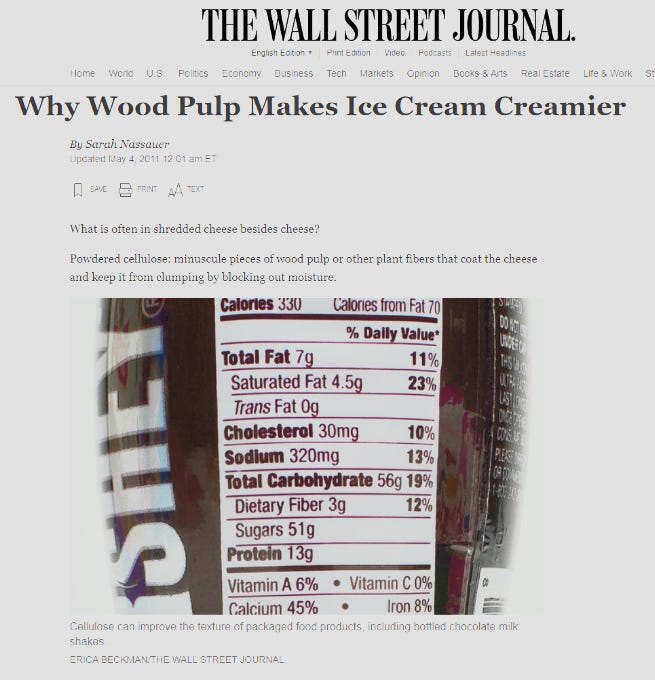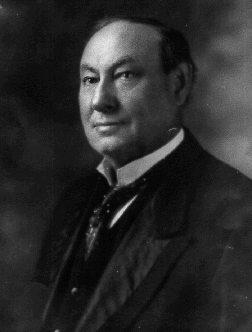Sawdust and Ice Cream
tldr; How the FDA has abandoned a core part of its mission: preventing the adulteration of food by non-food substances like sawdust.
"Selected food items adulteration, their impacts on public health, and detection methods: A review"
"For example, adding water to milk, sawdust to ground spices, or adding synthetic colors to fruits and vegetables are common forms of food adulteration..."
Go spend a little time on Google searching on the query 'sawdust food adulteration', and you'll find links like the one above. What is adulterated food?
"To make impure by adding extraneous, improper, or inferior ingredients."
And I came across this little gem of a poem:
We sit at a table delightfully spread,
And teeming with good things to eat,
And daintily finger the cream-tinted bread,
Just needing to make it complete
A film of the butter so yellow and sweet,
Well suited to make every minute
A dread of delight.
And yet while we eat
We cannot help asking “What's in it?
Oh, maybe this bread contains alum and chalk,
Or sawdust chopped up very fine,
Or gypsum in powder about which they talk,
Terra alba just out of the mine.
And our faith in the butter is apt to be weak,
For we haven't a good place to pin it
Annato's so yellow and beef fat so sleek,
Oh, I wish I could know what is in it?”
See the first post script for the author.
This is Food Safety 101.
If someone tries to sell you food containing sawdust, they should go to jail, because sawdust IS NOT FOOD.
So imagine my surprise the other day when I came across this article in the Wall Street Journal: "Why Wood Pulp Makes Ice Cream Creamier"
Since the Journal is subscription-only, I'll quote a bit of it. The article pretty much speaks for itself, I don't think I'll have to add much commentary for my regular readers:
"What is often in shredded cheese besides cheese?
"Powdered cellulose: minuscule pieces of wood pulp or other plant fibers that coat the cheese and keep it from clumping by blocking out moisture.
"One of an array of factory-made additives, cellulose is increasingly used by the processed-food industry, producers say. Food-product makers use it to thicken or stabilize foods, replace fat and boost fiber content, and cut the need for ingredients like oil or flour, which are getting more expensive....
"...The rising cost of raw materials like flour, sugar and oil is helping boost the popularity of these additives, producers of the ingredients say.
"Demand for cellulose is also rising because of the growing popularity of processed food products in China, India and other countries, and because consumers are demanding low-fat or nonfat foods that still have a creamy texture....
"Companies can save money by using it, even though it costs more by weight than conventional ingredients. Cellulose gives food 'more water, more air, a creamy feeling in [the] mouth with less of other ingredients,' and only a very small amount is needed, says Niels Thestrup, vice president of the hydrocolloids department for Danisco AS. The Copenhagen-based company makes ingredients and enzymes for food, cleaning supplies and other products....
"...Even organic-food products can contain cellulose.
"Organic Valley uses powdered cellulose made from wood pulp in its shredded-cheese products. The company would prefer not to use a synthetic ingredient, but cellulose is bland, white and repels moisture, making it the favored choice over products such as potato starch, says Tripp Hughes, director of product marketing for Organic Valley.
"Only powdered cellulose in its least manipulated form can be used in foods labeled 'organic' or 'made with organic' ingredients by the U.S. Department of Agriculture...." (Nassauer 2011)
Well, so the 'certified organic' label is a fraud, but that's hardly a shock, as it's a government label. Here's the key bit:
"Powdered cellulose is made by cooking raw plant fiber—usually wood—in various chemicals to separate the cellulose, and then purified. Modified versions go through extra processing, such as exposing them to acid to further break down the fiber.
"Although the notion of eating fine grains of wood pulp might make some consumers blanch, nutritionists say cellulose—which gives plants their structure—is a harmless fiber that can often cut calories in food. Insoluble dietary fibers like cellulose aren't digestible by humans so add bulk to food without making it more fattening.
"In the U.S., cutting calories from food doesn't cause a problem because the country is in the grip of an obesity epidemic, says Joanne Slavin, professor of food science and nutrition at the University of Minnesota. She served as chairwoman the carbohydrate committee of the 2010 Dietary Guidelines Advisory Committee.
"Cellulose can serve as a good source of dietary fiber for people who don't eat enough fruits, vegetables or whole grains, Ms. Slavin says. The USDA's most recent dietary guidelines recommend young women get 28 grams a day of fiber and young men consume 38 grams.
'Cellulose is cellulose,' regardless of if whether it comes from wood pulp or celery, says Michael Jacobson, executive director of the Center for Science in the Public Interest, a group that advocates healthier, more nutritious food. He says no research points to health problems related to consuming cellulose...." (Nassauer 2011)
Here is an article about "Dr." Slavin, first from Dr. Eades (who doesn't deserve the scare quotes around his title):
Here is one from Richard Nikoley, who doesn't have a Dr. in front of his name, but has the dual qualifications of being learned and honest:
“Avoiding entire food groups is a mistake, critics say”
Dr. Slavin has obviously gone beyond her statement in the first article that Richard links to above, where she says "Grains are really cheap, and for the average teenage boy it would cost a fortune to do this (Paleo) diet", now we can just eat sawdust, according to her, which is even cheaper! Brilliant!
Of course the Center for Science in the Public Interest is a trustworthy source. These are the brilliant vegetarians who strong-armed McDonalds into replacing beef tallow with hydrogenated vegetable oils (aka trans fats) for frying. Turns out trans fats are toxic. Just remember this when CSPI says, "...no research points to health problems related to consuming cellulose...". CSPI isn't concerned with research. They're pushing an agenda, and consuming any vegetable product is OK with them, research be damned.
If you're curious about the nutritional value of cellulose for humans, that's the point, it has none. Humans can't digest cellulose. This is the problem with adulterating food with sawdust: people think they're consuming something nutritious, but in reality, they're getting nothing.
We’re from the Government…
But don't worry, the government is on the case:
"The Food and Drug Administration sets limits on the amount of cellulose in certain foods like cheese spreads and jams. The USDA also limits the amount of cellulose in meat products to about 1% to 4%, depending on the type, in order to meet the agency's standards for protein content." (Nassauer 2011)
You're on your own, in other words.
I have to say, I wrote a post a while ago about MAD, the Modern American Diet. I prefer MAD to the common acronym, SAD, or Standard American Diet, because MAD captures the insanity of this whole enterprise. This was before I learned that people would prefer to eat sawdust to eating saturated fat.
What is Pica?
“Pica involves an individual persistently and compulsively eating nonfood substances that are non-nutritious.”
This is truly insane. Go to the sanitarium, do not wait for the guys in the white coats; insane.
Want to get yourself committed to an institution? Let someone catch you eating sawdust in preference to eating real food. Or, you can get a PhD and recommend this course of action.
Completely insane behavior. To put it bluntly, you're a fool if you trust the authorities about what to eat.
Here's a recipe for real ice cream, on the other hand, from the Perfect Health Diet. We made it today, and it is delicious, especially when made with premium ingredients like pastured egg yolks and pastured cream. We added a little extra berries and some maple syrup, and it was divine.
We skipped the sawdust. You may choose to do otherwise.
P.S.
Who wrote that poem? Dr. Harvey Washington Wiley. Who?
The founder (effectively) of the U.S. Food and Drug Administration.
"...Dr. Wiley's promotion of food safety resulted in passage of the Pure Food and Drug Act in 1906. Earlier attempts at such legislation had failed, and this landmark law was the first to regulate the development and production of safe foods and drugs. Both Wiley's administration of the law and concerns over preserving chemicals that had not been specifically addressed in the law caused some controversy. Nevertheless, under Wiley's leadership, the Bureau of Chemistry grew in size and stature after assuming responsibility for enforcement of the 1906 Act (FDA 2001).
The poor man must be rolling in his grave.
P.P.S.
Maybe we should all move to China. At least there they know what to do with people who put cardboard in the food.
“China To Execute Chief Food Inspector”
References
Haji, A., Desalegn, K., & Hassen, H. (2023). Selected Food Items Adulteration, Their Impacts on Public Health, and Detection Methods: A Review. Food Science & Nutrition, 11(12), 7534–7545. https://doi.org/10.1002/fsn3.3732
Nassauer, S. (2011, May 4). Why Wood Pulp Makes Ice Cream Creamier. Wall Street Journal. https://online.wsj.com/article/SB10001424052748703834804576300991196803916.html







Here in Israel, some Yogurt has the sawdust, and some doesn't.
The way I tell (without reading the ingredients), is by noticing the scratchy sensation all over my throat.
I can only imagine what this indigestible garbage does once it starts slicing the gut.
Ask anyone you know with Crohn's how they respond to this "safe and cheap" food stuff.
I'm curious about microcrystalline cellulose as used as a binder for some vitamins, such as this one. I like the vitamin but I'm not so sure about the binder....
https://www.amazon.com/dp/B07B6783MW
Serious question.